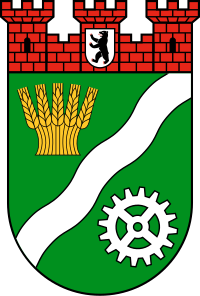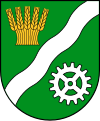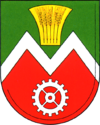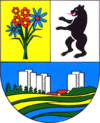Coat of arms of the Marzahn-Hellersdorf district
The symbols of the coat of arms of the Marzahn-Hellersdorf district are mainly taken from the coat of arms of the old Marzahn district. The district of Hellersdorf with its districts was part of the Marzahn district before it was founded. With the merger of the two districts, the symbols again represent exactly what they were when the coat of arms was formed.
The coat of arms was awarded on October 7, 2003 by the Berlin Senate .
Blazon
“In a green shield there is a slanting left silver wave bar, above it a golden sheaf of corn with five ears of wheat, below it a silver cogwheel. A red three-tower wall crown rests on the shield, the central tower of which is covered with the Berlin coat of arms. "
District symbol
The district symbol of Marzahn-Hellersdorf can be used freely as a sign of special affinity or a special reference to the district, if this is compatible with the meaning of the district symbol and does not violate legal regulations in the Federal Republic of Germany .
Use in or on seals, stamps or signs is not permitted.
history
Marzahn district
On May 20, 1979, the Marzahn district was formed. When it was founded, the district also got its coat of arms. Since the village of Marzahn did not yet have a coat of arms that could have been adopted for the district, a new one was created. The coat of arms was designed by the graphic artist Dietrich Dorfstecher . The coat of arms is green at the top and red at the bottom, divided by a silver "M". In the upper field there are five golden ears of corn and in the lower field there is a silver gear. The silver "M" symbolizes the district name Marzahn. The golden ears indicate the agricultural tradition of the districts. The number five symbolizes the five districts, Marzahn , Biesdorf , Hellersdorf , Kaulsdorf and Mahlsdorf , which were incorporated into the district when it was founded. For the beginning of the 20th century industrialization in all districts, the silver gear was added to the coat of arms. In the - at that time still - villages the first handicraft businesses, mills and smaller commercial enterprises emerged. With the beginning of the 1970s, industrialization intensified.
Hellersdorf district
In 1986 the districts of Hellersdorf, Kaulsdorf and Mahlsdorf were removed from the Marzahn district and formed the new Hellersdorf district . Since Hellersdorf, like Marzahn, did not have its own coat of arms, a new coat of arms had to be created here as well. It was designed by the Berlin sculptor Professor Gerhard Thieme and in the same year it was awarded to the district. The coat of arms is divided and half-split at the top. In front it shows a colorful flower arrangement in gold and behind in silver a red-tongued black bear walking upright to the right. Below are three silver high-rise complexes in the blue field, two of them on the right and one on the left, over blue water, golden fields and green meadows, embedded in a green fir forest (right) and deciduous forest (left). Between the high-rise complexes, behind the lines of fields and meadows, two red roofs with silver front gables stand out. The flower arrangement stands as a symbol for the LPG plant production located in the district , which not only grew food, but also cut flowers. The districts were able to maintain their village character until the end of the 1970s. The black bear symbolizes belonging to the city of Berlin. The landscape with the high-rise complexes in the lower field is intended to represent the development of the district. From an area rich in forests and meadows, through agriculture with villages and single-family houses, to a modern district of Berlin with new residential areas. The blue water in the lower part of the lower field symbolizes the Wuhle, which flows on the western district border, and the many small lakes.
| District coat of arms from 1992 | |

|

|
| Marzahn | Hellersdorf |
After the reunification of Germany and thus also of Berlin, the district coats of arms were revised again in September 1992 and were given the wall crown connecting all districts with Berlin, as the coats of arms of the districts in the western part of Berlin already had.
Marzahn-Hellersdorf district
As part of the district merger of January 1, 2001, the two districts of Marzahn and Hellersdorf were merged again into one, the district of Marzahn-Hellersdorf . Although the Hellersdorf district was once part of the Marzahn district, they did not want to use the old Marzahn coat of arms for the new district. The district office formed a coat of arms commission, which commissioned the heraldist Lutz Döring to design the new coat of arms. According to the specifications, the history of the five districts, the prefabricated buildings and single-family houses as well as the wealth of green and water areas should be reflected in the new coat of arms. The heraldist Lutz Döring worked out 18 drafts, of which the commission selected three and posted them in the citizens' offices for assessment. The coat of arms with the most approval was submitted to the Landesarchiv Berlin. But there was no unconditional approval. The once more revised coat of arms was then approved by the Senate Administration. On October 7, 2003, the coat of arms was awarded to the Marzahn-Hellersdorf district by the Senate. For description (blazon) see above .
The symbols of the new coat of arms of Marzahn-Hellersdorf come mainly from the coat of arms of the former Marzahn district. The sheaf of corn with ears of corn symbolizes the centuries-long agricultural character of all parts of the district. The corn sheaf consists of five ears of wheat, they symbolize the five districts of Biesdorf, Hellersdorf, Kaulsdorf, Mahlsdorf and Marzahn, which make up the district. The wave bar stands for the Wuhle , which flows through the district from north to south, and the many waters of the district. The green tinging of the sign stands for the spacious green areas and parks in the district. As in the old coat of arms of Marzahn, the cog symbolizes the strong industrialization of the district in the 20th century. Today, the Marzahn-Hellersdorf district is the largest contiguous industrial area in Berlin. This, too, is one reason why the gear was re-included in the new coat of arms.
Coats of arms of the districts
Mahlsdorf is the only one of the former villages that had its own coat of arms. The coat of arms of Mahlsdorf lost its validity when it was incorporated into Greater Berlin and disappeared from official use.
Mahlsdorf
The coat of arms was taken over from the "DORFSIEGEL ZV MAHLSDORF" from the middle of the 19th century. In the silver shield on the right, the coat of arms shows a leafy gallery-like clipped green linden tree leaning to the left on green ground. In the middle on the floor is a golden sheaf of grain, which is held together by a blue ribbon. The sheaf is equipped with an upright golden rake and a golden scythe with a steel-blue blade. The grain with the rake and the scythe indicates the agricultural activity of the inhabitants of the village. The grain is the main agricultural product and the rake and scythe were used by the farmers to harvest and mow the grain. The meaning of the tree is unclear as there are no longer any traditions that could explain it. From the oldest village seal to the last official seals of the community leader, all seals show the same representation with the strange curved tree and the highlighted handle on the throw of the scythe.
See also
literature
- Heinz Machatscheck: When the heraldic bear was born Berlin-Information, Berlin 1987, ISBN 3-7442-0005-1
- Werner Vogel: Berlin and its coat of arms Ullstein, Berlin 1987, ISBN 3-550-07818-8




